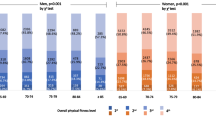Abstract
Introduction
There is increasing interest in physical performance as it relates to both the current and future health of older people. It is often characterised using the Short Physical Performance Battery including assessment of gait speed, chair rises and standing balance. However this battery of tests may not be feasible in all clinical settings and simpler measures may be required. As muscle strength is central to physical performance, we explored whether grip strength could be used as a marker of the Short Physical Performance Battery.
Objective
To examine associations between grip strength and components of the Short Physical Performance Battery in older community dwelling men and women.
Methods
Grip strength measurement and the Short Physical Performance Battery were completed in 349 men and 280 women aged 63–73 years taking part in the Hertfordshire Cohort Study (HCS). Relationships between grip strength and physical performance (6m timed-up-and-go [TUG], 3m walk, chair rises and standing balance times) were analysed using linear and logistic regression, without and with adjustment for age, anthropometry, lifestyle factors and co-morbidities.
Results
Among men, a kilo increase in grip strength was associated with a 0.07s (second) decrease in 6m TUG, a 0.02s decrease in 3m walk time, and a 1% decrease in chair rises time (p<0.001 for all). Among women, a kilo increase in grip strength was associated with a 0.13s decrease in 6m TUG, a 0.03s decrease in 3m walk time, and a 1% decrease in chair rises time (p<0.001). Higher grip strength was associated with better balance among men (p=0.01) but not women (p=0.57). Adjustment for age, anthropometry, lifestyle and co-morbidities did not alter these results.
Conclusions
Grip strength is a good marker of physical performance in this age group and may be more feasible than completing a short physical performance battery in some clinical settings.
Similar content being viewed by others
References
Cooper R, Kuh D, Hardy R. Objectively measured physical capability levels and mortality: systematic review and meta-analysis. BMJ 2010;341:c4467.
Guralnik JM, Simonsick EM, Ferrucci L, Glynn RJ, Berkman LF, Blazer DG et al. A short physical performance battery assessing lower extremity function: association with self-reported disability and prediction of mortality and nursing home admission. J Gerontol 1994 March;49(2):M85–M94
Studenski S, Perera S, Wallace D, Chandler JM, Duncan PW, Rooney E et al. Physical performance measures in the clinical setting. J Am Geriatr Soc 2003 March;51(3):314–322.
Ugboma I, Syddall HE, Cox V, Cooper C, Briggs R, Aihie SA. Coding geriatric syndromes: how good are we? CME Journal Geriatric Medicine 2008; 10(1):34–36.
Sirola J, Rikkonen T, Kroger H, Honkanen R, Tuppurainen M, Airatsinen O et al. Factors related to postmenopausal muscle performance: a cross-sectional population-based study. Eur J Appl Physiol 2004 October;93(1–2): 102–107.
Davis JW, Ross PD, Preston SD, Nevitt MC, Wasnich RD. Strength, physical activity, and body mass index: relationship to performance-based measures and activities of daily living among older Japanese women in Hawaii. J Am Geriatr Soc 1998 March;46(3):274–279.
Visser M, Newman AB, Nevitt MC, Kritchevsky SB, Stamm EB, Goodpaster BH et al. Reexamining the sarcopenia hypothesis. Muscle mass versus muscle strength. Health, Aging, and Body Composition Study Research Group. Ann N Y Acad Sci 2000 May; 904:456–461.
Baker JS, Davies B. Additional considerations and recommendations for the quantification of hand-grip strength in the measurement of leg power during high-intensity cycle ergometry. Res Sports Med 2009;17(3):145–155.
Stenholm S, Rantanen T, Heliovaara M, Koskinen S. The mediating role of C-reactive protein and handgrip strength between obesity and walking limitation. J Am Geriatr Soc 2008 March; 56(3):462–469.
Hughes S, Gibbs J, Dunlop D, Edelman P, Singer R, Chang RW. Predictors of decline in manual performance in older adults. J Am Geriatr Soc 1997 August;45(8):905–910.
Glenmark B, Hedberg G, Kaijser L, Jansson E. Muscle strength from adolescence to adulthood-relationship to muscle fibre types. Eur J Appl Physiol Occup Physiol 1994;68(1):9–19.
Bassey EJ. Longitudinal changes in selected physical capabilities: muscle strength, flexibility and body size. Age Ageing 1998 December;27Suppl 3:12–16.
Martin HJ, Syddall HE, Dennison EM, Cooper C, Sayer AA. Relationship between customary physical activity, muscle strength and physical performance in older men and women: findings from the Hertfordshire Cohort Study. Age Ageing 2008 September;37(5):589–593.
Newman AB, Haggerty CL, Goodpaster B, Harris T, Kritchevsky S, Nevitt M et al. Strength and muscle quality in a well-functioning cohort of older adults: the Health, Aging and Body Composition Study. J Am Geriatr Soc 2003 March; 51(3):323–330.
Rantanen T, Guralnik JM, Ferrucci L, Penninx BW, Leveille S, Sipila S et al. Coimpairments as predictors of severe walking disability in older women. J Am Geriatr Soc 2001 January; 49(1):21–27.
Buchner DM, Larson EB, Wagner EH, Koepsell TD, de Lateur BJ. Evidence for a non-linear relationship between leg strength and gait speed. Age Ageing 1996 September; 25(5): 386–391.
Syddall HE, Aihie SA, Dennison EM, Martin HJ, Barker DJ, Cooper C. Cohort profile: the Hertfordshire cohort study, Int J Epidemiol 2005 December;34(6):1234–1242.
Roberts HC, Denison HJ, Martin HJ, Syddall H, Patel H, Cooper C et al. A review of the measurement of grip strength in clinical and epidemiological studies: towards a standardised approach. Age Ageing. In press 2011
Stata Statistical Software [computer program]. Version 10.0. College Station, TX: Stata Corp LP; 2007.
Author information
Authors and Affiliations
Corresponding author
Rights and permissions
About this article
Cite this article
Stevens, P.J., Syddall, H.E., Patel, H.P. et al. Is grip strength a good marker of physical performance among community-dwelling older people?. J Nutr Health Aging 16, 769–774 (2012). https://doi.org/10.1007/s12603-012-0388-2
Received:
Accepted:
Published:
Issue Date:
DOI: https://doi.org/10.1007/s12603-012-0388-2




